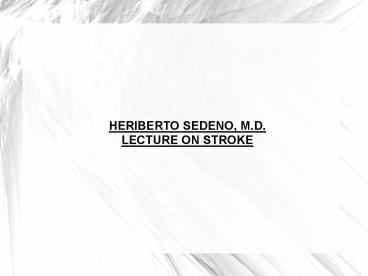HERIBERTO SEDENO, M.D. LECTURE ON STROKE - PowerPoint PPT Presentation
Title:
HERIBERTO SEDENO, M.D. LECTURE ON STROKE
Description:
A stroke—also called a cerebrovascular accident or "brain attack"—is a medical emergency where part of the brain is deprived of oxygen. – PowerPoint PPT presentation
Number of Views:58
Title: HERIBERTO SEDENO, M.D. LECTURE ON STROKE
1
HERIBERTO SEDENO, M.D. LECTURE ON STROKE
2
What is a Stroke? A strokealso called a
cerebrovascular accident or "brain attack"is a
medical emergency where part of the brain is
deprived of oxygen. This occurs when an artery
that supplies oxygenated blood to the brain
becomes damaged in one of several ways. Within
minutes of being deprived of oxygen, brain cells
begin to die. The longer the brain goes without
oxygenated blood, the greater the chances of
permanent damage. The death of brain cells
allows for the accumulation of toxic chemicals
that blood, when flowing properly, usually
removes from the brain. Without proper treatment,
the accumulation can affect nearby cells.
Potential damage from a stroke includes
paralysis, impaired speech, memory loss, coma, or
death.
3
Prompt treatment improves the chances for
survival and decreases the risk of brain damage.
Approximately 795,000 Americans suffer a stroke
each year. Of those who have a stroke, about
150,000 die each year, making it the third
leading cause of death in the country. About 75
percent of stroke victims are over the age of
65. Worldwide, there are 15 million strokes a
year. Of those, a third die and another third are
permanently disabled. Despite these daunting
statistics, thanks to education, prevention, and
medical advances, fewer people are dying from
strokes every year.
4
Types of Strokes A stroke is categorized by the
nature of the blockage and where it originates.
Two main categories of strokes are ischemic and
hemorrhagic. Ischemic Strokes Clots form in
arteries and block blood flow in a process called
ischemia, and there are two types of ischemic
strokes. When a clot originates in the brain and
blocks blood flow, it is called a thrombotic
stroke. A clot can also form in another part of
the body, such as the arm or heart, and then
travel through blood vessels and get lodged in
the brain. This is called an embolic stroke. The
two most common ischemic strokeswhich account
for about 75 percent of all strokesare as
follows
5
Cerebral Thrombosis Thrombosis is the medical
term for a blood clot. This type of stroke occurs
when a blood clot forms inside the brain,
blocking the flow of blood through a vessel. It
is often preceded by a smaller kind of stroke
known as transient ischemic attack (TIA)also
called a "mini stroke." Cerebral Embolism This
category of stroke occurs when a blood clot
breaks free from another part of the body, most
often the heart, and travels through the vessel
into the brain where it clogs an artery and
disrupts the flow of blood. Other categories of
ischemic strokes include strokes caused by blood
clots formed in the heart (often caused by
irregular heartbeat, heart attack,
6
or abnormalities of the heart valves), those
caused by blood clotting disorders, and those
caused by traumatic injury to the blood vessels
in the neck.Overall, clots are responsible for
about 90 percent of all strokes. Hemorrhagic
Strokes A stroke can also occur when a blood
vessel breaks or bursts, known as a hemorrhage.
The two most common types of hemorrhagic strokes
are as follows Subarachnoid Hemorrhage
Hemorrhage occurs when a blood vessel breaks
inside the brain. This is most likely to occur in
an area of aneurysm, or weakening, in the wall of
the vessel. Intracerebral Hemorrhage This type
of hemorrhaging involves small vessels deep
within the brain tissue.































